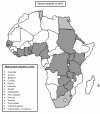Availability of critical care resources to treat patients with severe sepsis or septic shock in Africa: a self-reported, continent-wide survey of anaesthesia providers
- PMID: 21219619
- PMCID: PMC3222039
- DOI: 10.1186/cc9410
Availability of critical care resources to treat patients with severe sepsis or septic shock in Africa: a self-reported, continent-wide survey of anaesthesia providers
Abstract
Introduction: It is unknown whether resources necessary to implement the Surviving Sepsis Campaign guidelines and sepsis bundles are available in Africa. This self-reported, continent-wide survey compared the availability of these resources between African and high-income countries, and between two African regions (Sub-Sahara Africa vs. South Africa, Mauritius and the Northern African countries).
Methods: The study was conducted as an anonymous questionnaire-based, cross-sectional survey among anaesthesia providers attending a transcontinental congress. Based on the respondents' country of practice, returned questionnaires were grouped into African and high-income countries. The questionnaire contained 74 items and evaluated all material resources required to implement the most recent Surviving Sepsis Campaign guidelines. Group comparisons were performed with the Chi2, Fisher's Exact or Mann Whitney U test, as appropriate.
Results: The overall response rate was 74.3% (318/428). Three-hundred-seven questionnaires were analysed (African countries, n = 263; high-income countries, n = 44). Respondents from African hospitals were less likely to have an emergency room (85.5 vs. 97.7%, P = 0.03) or intensive care unit (73.8 vs. 100%, P < 0.001) than respondents from high-income countries. Drugs, equipment, and disposable materials required to implement the Surviving Sepsis Campaign guidelines or sepsis bundles were less frequently available in African than high-income countries. Of all African and Sub-Saharan African countries, 1.5% (4/263) and 1.2% (3/248) of respondents had the resources available to implement the Surviving Sepsis Campaign guidelines in entirety. The percentage of implementable recommendations was lower in African than in high-income countries (72.6 (57.7 to 87.7)% vs. 100 (100 to 100)%, P < 0.001) and lower in Sub-Saharan African countries than South Africa, Mauritius, and the Northern African countries (72.6 (56.2 to 86.3)% vs. 90.4 (71.2 to 94.5)%, P = 0.02).
Conclusions: The results of this self-reported survey strongly suggest that the most recent Surviving Sepsis guidelines cannot be implemented in Africa, particularly not in Sub-Saharan Africa, due to a shortage of required hospital facilities, equipment, drugs and disposable materials. However, availability of resources to implement the majority of strong Surviving Sepsis Campaign recommendations and the sepsis bundles may allow modification of current sepsis guidelines based on available resources and implementation of a substantial number of life-saving interventions into sepsis care in Africa.
Figures
Comment in
-
Fitting a square peg into a round hole: are the current Surviving Sepsis Campaign guidelines feasible for Africa?Crit Care. 2011;15(1):117. doi: 10.1186/cc9981. Epub 2011 Feb 1. Crit Care. 2011. PMID: 21345262 Free PMC article.
References
-
- Engel C, Brunkhorst FM, Bone HG, Brunkhorst R, Gerlach H, Grond S, Gruendling M, Huhle G, Jaschinski U, John S, Mayer K, Oppert M, Olthoff D, Quintel M, Ragaller M, Rossaint R, Stuber F, Weiler N, Welte T, Bogatsch H, Hartog C, Loeffler M, Reinhart K. Epidemiology of sepsis in Germany: results from a national prospective multicenter study. Intensive Care Med. 2007;33:606–618. doi: 10.1007/s00134-006-0517-7. - DOI - PubMed
-
- World Bank. World Bank list of economies. 2009. http://siteresources.worldbank.org/DATASTATISTICS/Resources/CLASS.XLS
Publication types
MeSH terms
LinkOut - more resources
Full Text Sources
Medical


